ECS X79R-AX (Black Extreme) Review
by Ian Cutress on January 13, 2012 12:30 PM EST- Posted in
- Motherboards
- ECS
- X79
USB Speed
For this benchmark, we run CrystalDiskMark to determine the ideal sequential read and write speeds for the USB port using our 64GB Patriot SuperSpeed USB 3.0 drive. Then we transfer a set size of files from the SSD to the USB drive, and monitor the time taken to transfer. The files transferred are a 1.52 GB set of 2867 files across 320 folders – 95% of these files are small typical website files, and the rest (90% of the size) are the videos used in the Sorenson Squeeze test.
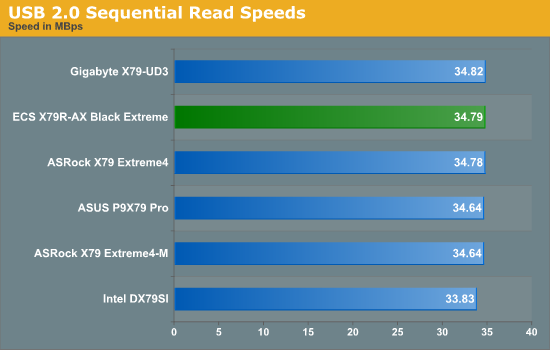
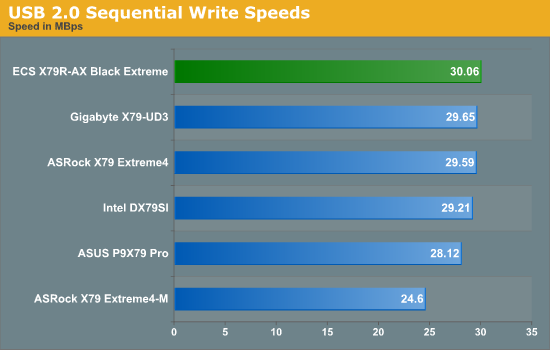
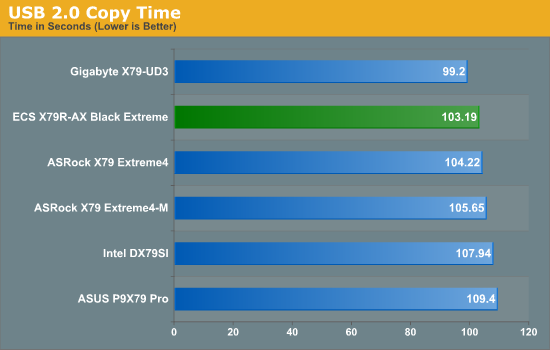
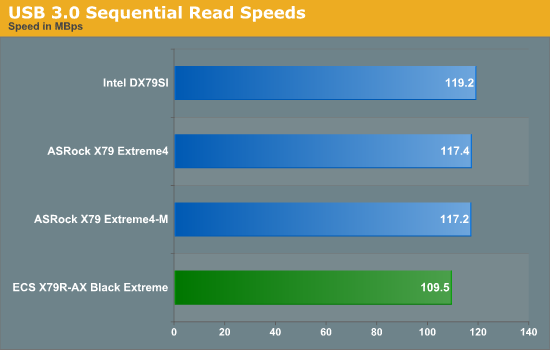

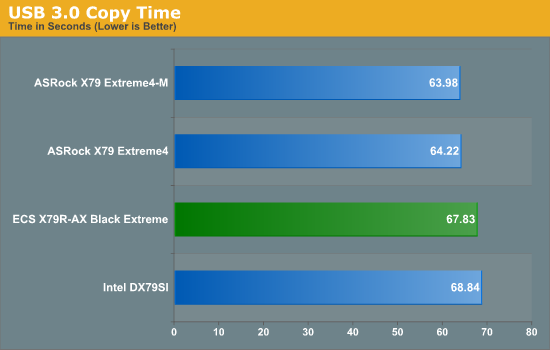
USB 2.0 performance on the X79R-AX seems comparatively on the high end, whereas USB 3.0 performance seems not as good as the ASRock boards.
SATA Testing
We also use CrystalDiskMark for SATA port testing. The operating system is installed on the SSD, and the sequential test is run at the 5 x 1000 MB level. This test probes the efficiency of the data delivery system between the chipset and the drive, or in the case of additional SATA ports provided by a third party controller, the efficiency between the controller, the chipset and the drive.
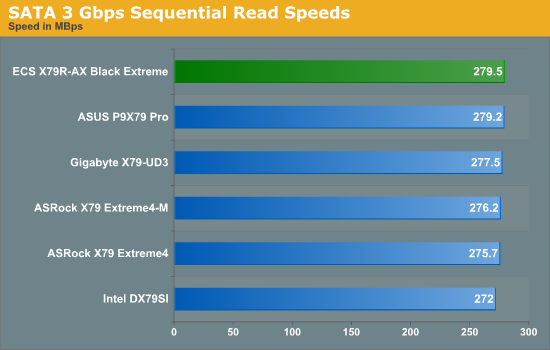


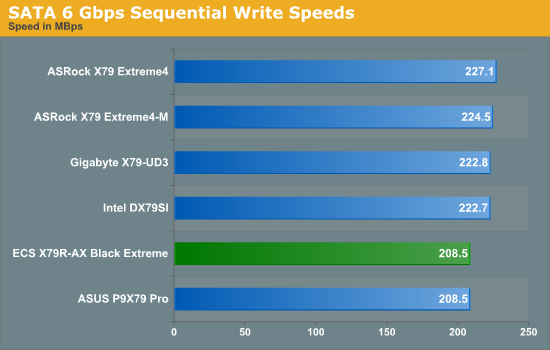
Similarly, the ECS board peforms better on the old standard than the new standard.
DPC Latency
Deferred Procedure Call latency is a way in which Windows handles interrupt servicing. In order to wait for a processor to acknowledge the request, the system will queue all interrupt requests by priority. Critical interrupts will be handled as soon as possible, whereas lesser priority requests, such as audio, will be further down the line. So if the audio device requires data, it will have to wait until the request is processed before the buffer is filled. If the device drivers of higher priority components in a system are poorly implemented, this can cause delays in request scheduling and process time, resulting in an empty audio buffer – this leads to characteristic audible pauses, pops and clicks. Having a bigger buffer and correctly implemented system drivers obviously helps in this regard. The DPC latency checker measures how much time is processing DPCs from driver invocation – the lower the value will result in better audio transfer at smaller buffer sizes. Results are measured in microseconds and taken as the peak latency while cycling through a series of short HD videos - under 500 microseconds usually gets the green light, but the lower the better.

While under the 500 microseconds we want from the DPC test, the default ECS X79R-AX latency is high compared to other X79 boards.










36 Comments
View All Comments
PhoenixEnigma - Sunday, January 15, 2012 - link
Agreed.When I see an Anandtech Editor's Choice award, I expect whatever product is to be substantially above average in most, if not all, regards. They're pretty rare, and carry a good deal of weight in my eyes.
Seeing something like this be given one devalues that. Performance is middling at best, expandability is mixed, warranty is below average, and the EFI appears to be a steaming pile of crud - even clearing CMOS is faulty!
It's a cheap board (if you trust the MIR), but it seems to be in both price and quality, corners have been cut all over. Short of Ian verifying those are indeed SAS ports, I have a hard time imagining how this is "Editor's Choice" better than, say, the GA-X79-UD3 - which doesn't need a MIR to hit the same pricepoint.
IanCutress - Sunday, January 15, 2012 - link
This is only the second award I've given in twelve months over 20+ reviews - the other being the ASUS P9X79 Pro. After testing the board, I'd be happy to stick it into a system, use the one button 4.5 GHz overclock and leave it there, and still have access to 12 SATA ports (I should add ECS doesn't guarantee SAS compatibility with these, for all intents and purposes they are best left to be used as SATA), dual gigabit Ethernet, Wifi and Bluetooth. The GA-X79-UD3 you mention in comparison has 6 SATA ports, a single Ethernet port, no Wifi or Bluetooth, a comparatively worse automatic overclock system, not a full range of fan controls and perhaps questionable software.Editor's Choice awards aren't there just for the biggest, best and brightest - otherwise we'd be putting them on every board at the highest price point that checked all the boxes. They're meant for hardware that as a reviewer, I'd happily use, and it ticks all my boxes. These may not be the same boxes as yours, sure, but a board that caters for one group of users may not suitable for another group, meaning that I have to levy my judgement over my experiences with what I'm happy with.
This is why I've given so few over the past 12 months - the ECS board has been given a Bronze award while the rebate is in place, as the price is a big factor given the comparison to other products. I've yet to give a gold award at all, because no one board I've seen has been a perfect (features, performance, price) must buy. You may disagree with my choice to give this ECS board an award, which is your right. But in my opinion, after testing the board and conversing back and forth on some of the finer points with ECS, that it deserves one at the $260 price point.
kloudykat - Sunday, January 15, 2012 - link
Back in April 2009, I was building a new system.I scanned newegg and eventually settled on a brand new "enthusiast" motherboard from ECS.
It was the ECS BLACK SERIES X58B-A, the 1366 chipset one.
I bought it because I had built a few pc's for other people using ECS boards, so I knew it would work.
Here are the other components if anyone is interested:
Intel Core i7-920 Bloomfield 2.66GHz LGA 1366 130W Quad-Core Processor
G.SKILL 6GB (3 x 2GB) 240-Pin DDR3 SDRAM DDR3 1333 (PC3 10666) Triple Channel Kit
BFG Tech BFGEGTX260MC896OCE GeForce GTX 260
CORSAIR Enthusiast Series CMPSU-650TX 650W Power Supply
Pioneer DVD Burner
Bunch of hard drives, 1x 360 gb main drive, 2x 1.5TB and 1x 1TB storage drives
Once I got it all installed, I found I was unable to overclock it at all.
Now I am not an OC king or anything, but I have managed to successfully OC some systems in the past.
No matter what I attempted to do in the BIOS, manual or auto OC, it would fail to boot.
With that said, if I left it alone and kept it at the stock frequencies, it worked great. It still works great.
Heck, I am posting this on it right now.
But what rubbed me the wrong way was that ECS marketed this as an OC friendly board, when in reality, it was nothing of the sort.
I agree with Ian, the bios OC options are confusing as hell, at least on my board.
I made sure to update to the latest BIOS and that didn't help anything.
I even made it a point to contact ECS customer support for assistance.
I followed the guidelines they emailed me and it still didn't work.
When I contacted them again to inquire about replacement/money back/etc, I was told basically tough luck.
Ok, thats it. That is my 2 cents. So yeah, I agree with you Ian. It is a good board. I have used it as my
main pc for 3 almost 4 years in a row. It has done nothing but good things for me. I just hope that
you have better luck out of this model than I did out of mine.
AlexIsAlex - Monday, January 16, 2012 - link
What would be nice, in motherboard reviews, would be a measure of the cold boot (POST) time. This is something that different bioses can be differentiated on, and UFEI offers the potential for very fast boots if manufacturers take advantage of it properly.Would it be possible to report, for comparison, the time between the power button being pressed and the installed bootloader starting? I was thinking it might be easiest to measure this by having no OS on the boot media and measuring the time to the "please insert boot media" message, but I'm sure you can think of other ways of doing it.
DanNeely - Tuesday, January 17, 2012 - link
I'd like to second this request, and that it include both normal and overclocked times. My current LGA1366 system spends almost half its boot time posting and half loading the OS from my SSD. (20s power to beep, 10s beep to appearance of OS loading screen, 20s more to login). At stock speeds the first interval is less than half as long.Lugaidster - Tuesday, January 17, 2012 - link
I wonder why boot time is not included given that it should be affected by the firmware. At least I would expect bigger differences than the results on the computation benchmarks.